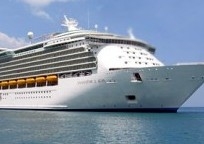Cruise tourism gaining momentum

Cruise tourism is gaining momentum in the UAE as Abu Dhabi, Dubai and Sharjah have been adopting drastic steps to attract big players of the industry, experts say.
All three emirates have been making significant investments in infrastructure to support cruise tourism facilities and services in the country. Abu Dhabi has erected a new tented cruise terminal at Mina Zayed, Dubai is reshaping Port Rashid and Sharjah is focusing on Khorfakkan to attract around 700,000 cruise visitors during this season.
Dubai will take the lead in total cruise visitors as it is expected to welcome 475,000 passengers at Port Rashid during this season. The Dubai Department of Tourism and Commerce Marketing, or DTCM, forecasts a steady growth for the next four years with 625,000 passengers by 2015, a 38 per cent increase over 2010 figures.
Realising the potential in cruise tourism, DP World is expanding Port Rashid cruise terminal facilities to continue its leading position as the largest cruise centre in the Middle East. It will expand the current facilities by the end of 2012 to cater for as many as five cruise ships at one time, against its current capacity of accommodating only two ships.
“Development of the cruise terminal facilities at Port Rashid supports Dubai’s long-term strategy to stimulate growth and development in the traditionally strong tourism sector,” DP World chairman Sultan Ahmed bin Sulayem recently said in an e-mailed statement to Khaleej Times. He said the new facility will help Dubai tap into the rapidly-growing cruise sector and will continue to be a major destination for the finest cruise ships in the world.
Cruise tourism is a key growth segment which will bring great economic benefits to the region, increasing overall expenditure in the tourism sector and boosting the economy. According to DTCM, cruise tourism saw an annual income of Dh338 million in 2010 and is estimated to grow to Dh837 million in 2015. This will see a yield of Dh3.5 billion into Dubai’s economy over those years.
The Abu Dhabi Tourism Authority, or ADTA, in collaboration with industry stakeholders Abu Dhabi Ports Company, or ADPC, and Abu Dhabi Terminals, is also increasing investing in cruise terminal facilities. The ADTA has prioritised cruise tourism as one of its five 2011-2012 strategy pillars and likely to receive around 170,000 tourists before the season ends in April next year. In line with its long-term cruise ambitions, the ADTA is planning to replace the tented terminal with a purpose-built cruise terminala at Mina Zayed as the emirate realises its aim to become a regional cruise hub.
“Cruise shipping has enjoyed strong recession-proof growth for many years,” ADTA director-general Mubarak Al Muhairi told Khaleej Times at the launch ceremony of new cruise terminal at Mina Zayed in October.
Capt Mohamed Al Shamisi, ADPC’s vice-president (operations) of ports unit, hoped the cruise business will continue to grow to 300 calls and 600,000 passengers by 2030.
“Ultimately, our capacity to build the cruise tourism business will rely on a combination of good planning, good infrastructure, strong marketing and industry co-operation,” Al Muhairi said.
Sharjah makes for an ideal destination for luxury cruise liners due to its strategic location, overlooking both the Gulf of Oman and Arabian Gulf Coast, as well as the natural splendour of the East Coast. The emirate’s picturesque East Coast is getting ready to welcome thousands of cruise passengers aboard some of the biggest and celebrated luxury cruise liners in the next few months. The third-largest emirate is expected to receive 67,000 cruise passengers during this season.
Sharjah, which has been attracting an extraordinary number of European tourists in recent years, is looking forward to receiving more international visitors as major cruise liners target the region. The first Costa Classica ship arrived at the Khorfakkan port last week with 1,700 passengers onboard, heralding the arrival of new season of luxury cruise liners and thousands of international tourists to Sharjah’s East Coast. Another large vessel, the Costa Favalosa, will make its maiden call at the Khorfakkan port on December 19 with 3,800 passengers.
“Between November and May 2012, two major cruise liner operators, Costa Cruises and Seabourn, will bring an estimate volume of nearly 67,000 international cruise passengers to Sharjah’s golden beaches, blue waters and breathtaking landscape,” according to a statement by the Sharjah Commerce and Tourism Development Authority.
The cruise tourism sector in the Middle East is seeing a steady increase in passengers as the sector gains traction in the region. Countries in the region are increasingly investing to support cruise tourism facilities and services. The Gulf is also witnessing a rise in cruise ships, with Costa Cruises, the first major line to introduce Gulf itineraries, upping capacity by 16 per cent this winter season. Other major cruise lines such as Costa, Royal Caribbean and MSC also plan to expand thier operations in the days to come.
Worldwide, the cruise industry has had an annual passenger compound annual growth rate of 7.67 per cent from 1990-2011, according to Cruise Market Watch. Last year cruise industry recorded 15 million guests and this year it is expected to achieve 19 million cruise guests. The UAE, with increased investment in cruise terminals, is expected to grab a major slice of this market by attracting big players of the industry.















